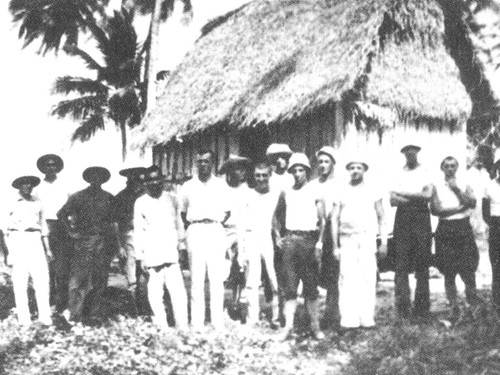Leprosy – Local Reaction
Local reaction contradicts Naval authorities
In the first decade of the 20th century, the US Navy embarked on a policy of forcibly segregating Chamorros suspected of having Hansen’s disease (leprosy) from the rest of Guam’s population, and sending them to live in leper colonies such as the one established at Ypao, Tumon or as far away as on the island of Culion in the Philippines. These patients were torn from their families and were denied basic civil liberties. The Navy saw the quarantines as a necessary measure to stop the spread of the disease.
The Chamorro people’s reaction to the quarantine was outrage. Many defied laws by continuing to visit, help and even free their sick family members from the colony.
Acceptance of the disease, a general discomfort with American medicine, and desire to care for their loved ones and to keep the family together, led to many attempting to hide their sick family members. In 1904, Governor G.L. Dyer wrote that patients:
…prefer to live with their families who have always had them and who regard it as an unwarranted and unnecessary interference to require them to part.
Naval Governor G.L. Dyer
By 1910 the Naval government began prosecuting Chamorros who concealed sick family members. Many Chamorros also defied rules against visitation to see those imprisoned at the colony. Additionally, there were reports of lepers escaping the colony to nearby ranches and homes. Punishment for escaping the colony was 10 to 20 days – or up to six months for repeat offenders – wearing a ball and chain.
Navy’s reasons for sequestering patients
The Navy’s reasons for attempting to stop the spread of leprosy on the island were complex, and not the least of which was protecting servicemen and their families from contagion. While there were few military personnel who disagreed with the Navy administration’s handling of the situation, and expressed their concerns that the extent of prevalence of the disease was overblown, their voices were ignored.
Although other factors were expressed in Naval writings from this period, such as a benevolent desire to help the local people and the less benevolent inclination to preserve a healthy local workforce, the Navy primarily acted out of self-preservation from what they saw as a deadly threat. In Colonial Dis-Ease Anne Perez Hattori writes:
…understandably, the paramount concern of the Naval government of Guam was the protection of their military personnel. The health concerns of the Chamorro people would be attended to, particularly if perceived as a threat to the well-being of the Naval community, essentially in the interest of shielding Americans from possible contagion. Understandings of Naval benevolence toward Chamorros must therefore be tempered by recognition that the health of Chamorros mattered to the Navy principally when it endangered the health of Navy enlistees through possible contagion.
Dr. Anne Perez Hattori
In 1902, Guam Naval Governor Seaton Schroeder issued General Order 43, establishing the colony at Ypao, Tumon and called for the arrest and confinement of people thought to be afflicted with Hansen’s disease. The order also spelled out punishments for patients who attempted to leave the colony, and for people who tried to hide or help escape those afflicted with the disease.
“Lepers” banished
The failure of the Naval government to totally confine sick Chamorros, local defiance to the measures, the administration’s lack of understanding, but more their fear of possibly contracting Hansen’s disease and the costs of confining and feeding the patients forced the first exile of eighteen Chamorros from their homeland and families to Culion Island, Philippines where a larger colony was already established. In December 1912, Guam Naval Governor R.E. Coontz received orders to banish the Chamorro patients to the Philippines.
As they were made to walk from Tumon to Apra Harbor to board the USS Supply hundreds of Chamorros lined the streets to bid farewell to friends and relatives that they knew that they would possibly never see again. Coontz would later write in his autobiography, From the Mississippi to the Sea:
In December 1912, I received orders to transport all the lepers, then in Guam, to Culion Island, in the Philippines. It had to be done ostensibly on account of economy, but it was a heart rendering procedure. On the way from the leper colony to the steamer it was necessary for all the unfortunates to pass through the town. Their relatives and many other natives congregated to see them go. It made one think either of a circus parade or a big funeral. One leper was 88-years-old and whether or not he survived the trip I never learned.
Naval Governor R.E. Coontz
The exile ended in 1924 when Navy Surgeon Edward Reed successfully argued that the banishment policy only served to worsen the patients’ health conditions and the Navy would never receive the Chamorro people’s cooperation to effectively identify leprosy cases if they kept sending their loved ones away.
For further reading
Angeny, G.L. “Leprosy in Guam.” The Military Surgeon: Journal of the Association of Military Surgeons of the United States 25, no. 1 (July 1909): 312-317.
Hattori, Anne Perez. Colonial Dis-ease: U.S. Navy Health Policies and the Chamorros of Guam, 1898-1941. Pacific Islands Monograph Series 19. Honolulu: University of Hawai`i Press, 2004.


